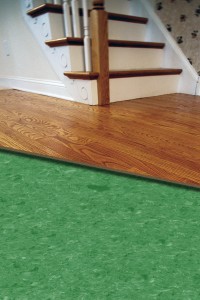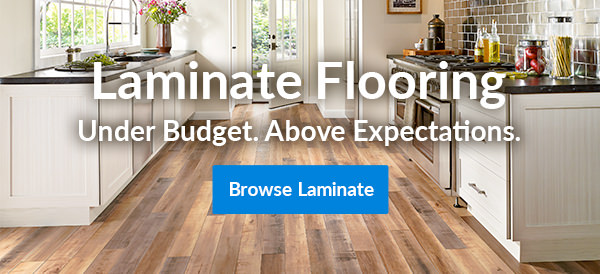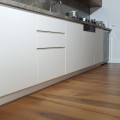Laminate Flooring Underlayment

Underlayment is a vital addition to your laminate floor installation and serves many functions. It adds a level of comfort to laminate floors, provides soundproofing qualities, and protects the flooring from moisture. It also ensures that the installation surface is perfectly level.
Here are some of the main types of underlayment that are most commonly used with laminate and other types of wood flooring. Each has different characteristics and will add a specific benefit to your flooring project.
Laminate Underlayment Options
Standard Foam Underlayment
This is the most common laminate underlayment available. This thin, foam padding usually measures 1/8 inch thick, and is available in different roll sizes.
Foam underlayment does not have a built-in moisture barrier. It’s best for areas where you expect minimal moisture. However, you can use it in conjunction with a plastic sheet if moisture is expected. You should not typically use foam underlayment with laminate flooring, as it provides minimal sound reduction.
Combination Underlayment
Combination underlayment is essentially the same as a standard foam type, but comes with a moisture barrier attached. This prevents moisture from seeping into your laminate from underneath. Install it in areas with higher levels of expected moisture, such as basements or kitchens. Its thickness is the same as a standard foam type and is sold in various-size rolls.
Acoustical/Sound Dampening Underlayment
This type of underlayment reduces the hollow sound from walking on a laminate floor. It is available in a variety of materials like cork and felt, and usually comes with a moisture barrier. Install acoustical underlayment without a moisture barrier attached together with a moisture barrier placed directly over the subfloor.
Vinyl-Backed Underlay
Vinyl-backed is a practical option because it comes in an easy-to-install tile form. It lays flat during installation and provides noise-proofing qualities. The seams must be sealed, though, if moisture-proofing is a priority.
For any project, it is best to ask the opinion of experts who can help you make the best choice for your space. Talk with a knowledgeable BuildDirect product expert for more advice on the best laminate underlayment to use in your flooring installation.






Brenda
I want to lay lock & fold plank on cement floor. What kind of underlayment do I use and how do I keep it from moving
Anita Wolfhope
I am looking to install laminate flooring in my basement thinking of the 12mm what underlayment do you recommend using. I will be putting this on cement flooring.
Also is there some sort of heating you can put on the cement then the laminate on top?
Vinyl vs laminate for the floor in by basement? It is underground. I have had water once in 28 yrs.
Any help is appreciated.
BuildDirect Product Expert Team
Hi Anita,
Thank you for getting in touch! You can use water radiant under floor heating under most laminate and vinyl planks but you will need to check the specific warranty of the floor just in case.
The best underlayment for laminate on top of concrete is the one I have linked below. It not only protects the laminate from the concrete but it will slowly absorb and release any moisture that may occur in a way that does not harm your floor.
https://www.builddirect.com/p/SoundChoice-Underlayment–10074922
I usually suggest going with vinyl in a basement if you have had water because it is water resistant. Although you may have only had water in the basement once in 28 years, if it does happen again the laminate would be completely ruined whereas the vinyl should be fine. Please let us know if you have any other questions!
Shannon
We are installing 8MM flooring, it has some padding on it but do we need to have more? If so what is best?
Thanks!
BuildDirect Product Expert Team
Hi Shannon. Thanks for reaching out to us! Just to confirm, your material has an underpad attached, correct? If it does, then it will depend on what type of subfloor you have. If you have a concrete subfloor, then you would need a MoistureBlock: https://www.builddirect.com/Underlay/MoistureBlock-Vapor-Barrier—100-sq-ft-Roll/ProductDisplay_10575_p1_10076337.aspx , but if it’s a wood subfloor, then you wouldn’t require anything further. Please let us know if you have any other questions!
Mark
Hello
I’m about to do a lamanite flooring in my trailer. Not too sure on how to do the underlay? Which kind would be best for a high moisture area? Also, how do i tack it down? Should I drop of a few nails in it or just lay it there.
Thanks for your time
BuildDirect Product Expert Team
Hi Mark,
Thank you for getting in touch! The installation of the underlay will depend on the type you choose. With most, you just lay down and tape. Others have a sticky edge included to adhere down to the subfloor. The option I recommend for high moisture is listed below:
https://www.builddirect.com/Underlay/SoundChoice-Underlayment-With-Moisture-Barrier—100-sq-ft-Roll/ProductDisplay_10575_p1_10074922.aspx?bdpdp=new
Please let us know if you have any other questions!
Ron Eldridge
I am about to install my Laminate flooring on a heated cement floor ( well cured) My laminate flooring is a 12 mil with a cushion already on it, I purchased underlay with a vapour barrier to add to the flooring. Is this wise with a heated cement floor ?
BuildDirect Product Expert Team
Hello Ron,
If you’re flooring has an underpad attached then you do not want to add a second underpad beneath. Only a vapor barrier would be needed in that scenario and as long as the flooring you purchased is rated for underfloor heating then that should be fine.
raj
I’m installing 12mm laminate flooring over concrete single family residence. I have the moisture barrier down than a 4mm sound barrier pad over it. Do I need a layer of plastic over the pad before I lay down the floors. I’m using the sound barrier pad because i got it for free. Live in Sacramento Ca the temps in winter gets in the 40 degree range in the winter and summer as high ad 110.
BuildDirect Product Expert Team
Hello Raj,
You don’t need another moisture barrier beneath the sound pad and the flooring. I would suggest checking if the sounds pad already has a moisture barrier incorporated into it as that is very common. It would save you from using double the moisture barrier. Please let us know if there is anything else we can help out with!
Dustin Mahon
I’m going to install a electric heating floor system (its basically like a big heating blanket material) under my laminate floor. But before I put any of these down i need to come up with a moisture barrier to put down first that will allow me to put the heat material over top of (moisture barrier) and then laminate floor over top of (heat material) correct??? Reason for all this being is i get a lot of water through my basement right now which will get fixed but not till later down the road. The new floor will be installed on the first floor……..So i need some ideas or thoughts. Facts always help too……Please and Thank you
Judy
Is it better to use laminate with backing or without backing. If without backing then what underlayment should be used?